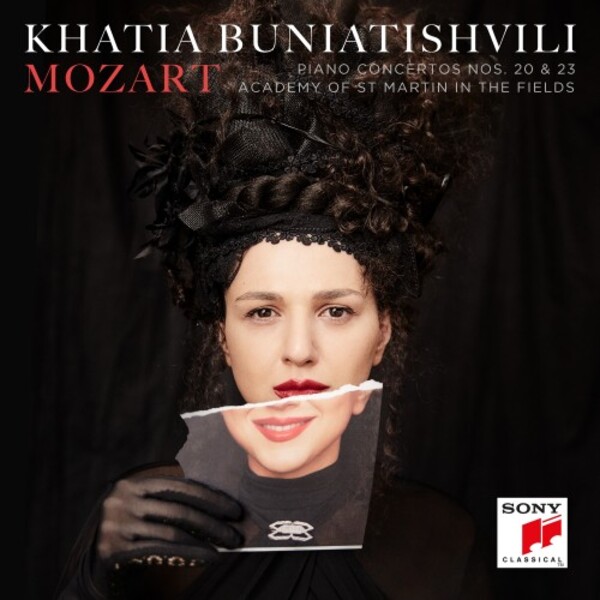MOZART Piano Concertos (Khatia Buniatishvili. Dejan Lazić)
View record and artist detailsRecord and Artist Details
Genre:
Orchestral
Label: Sony Classical
Magazine Review Date: 02/2025
Media Format: CD or Download
Media Runtime: 68
Mastering:
DDD
Catalogue Number: 19802 80928-2

Tracks:
| Composition | Artist Credit |
|---|---|
| Concerto for Piano and Orchestra No. 20 |
Wolfgang Amadeus Mozart, Composer
Academy of St Martin in the Fields Khatia Buniatishvili, Piano |
| Concerto for Piano and Orchestra No. 23 |
Wolfgang Amadeus Mozart, Composer
Academy of St Martin in the Fields Khatia Buniatishvili, Piano |
| Sonata for Piano No. 16 |
Wolfgang Amadeus Mozart, Composer
Khatia Buniatishvili, Piano |
Genre:
Orchestral
Label: Challenge Classics
Magazine Review Date: 02/2025
Media Format: CD or Download
Media Runtime: 72
Mastering:
DDD
Catalogue Number: CC72946

Tracks:
| Composition | Artist Credit |
|---|---|
| Concerto for Piano and Orchestra No. 21, 'Elvira Madigan' |
Wolfgang Amadeus Mozart, Composer
Bergen Philharmonic Orchestra Dejan Lazic, Piano Jan Willem de Vriend, Conductor |
| Rondo for Keyboard and Orchestra |
Wolfgang Amadeus Mozart, Composer
Bergen Philharmonic Orchestra Dejan Lazic, Piano Jan Willem de Vriend, Conductor |
| Concerto for Piano and Orchestra No. 9 |
Wolfgang Amadeus Mozart, Composer
Bergen Philharmonic Orchestra Dejan Lazic, Piano Jan Willem de Vriend, Conductor |
Author: David Threasher
Dejan Lazić’s track record in Mozart is well established, as is his collaboration with Jan Willem de Vriend and the Bergen Philharmonic, while Khatia Buniatishvili makes her first foray into the composer’s music play-directing a different concerto pairing with the Academy of St Martin in the Fields. Both are highly personal projects, displaying distinctive and contrasting approaches to Mozart from two of the most prominent pianists of their generation.
Buniatishvili’s Mozart is distinguished by the pearlescent tone she draws from a beautifully regulated piano (at London’s Air Studios). Her determination to exploit the full dynamic range of the instrument, though, tempts her too often into attention-seeking pianissimos, coyly retreating into the shadows when a touch more brazen assertiveness is called for. Once would be delightful, twice a tease, but it becomes a mannerism and, sadly, somewhat predictable. The finale of the D minor Concerto, K466, opens not with a self-assured rocket up the arpeggio but a rather apologetic mezzo-piano, blunting the angular Sturm und Drang that propels the work.
All the same, there is much that is admirable. Buniatishvili’s unfussy way with slow movements, leaving their vocally inspired melodic lines largely unadorned, is a refreshing change from the current fashion for over-ornamentation, especially in the central Adagio of the A major Concerto, K488 – even if the main body of that movement is considerably faster than the deliberate six-to-the-bar of her framing solos. And she leads the ASMF a merry dance in the cat-and-mouse games of the same work’s finale, although her little tugs at the tempo mean that coordination between piano and orchestra begins to fray a little in one or two places. Her major indulgence is to adopt an interventionist approach to Mozart’s dynamics, usually bringing the benefit of enhancing the rhetorical shaping of lines but just occasionally making them sound forced and slightly unnatural.
Buniatishvili mines the cadenzas for full expression, opting for Beethoven’s in K466, sticking with Mozart’s in K488. Lazić supplies his own stylish (but rather long) cadenzas in his chosen concertos, bridging the centuries between Mozart’s and our own, introducing ingenious juxtapositions of themes and tonalities. His is a terser view of Mozart than Buniatishvili’s, more sparingly pedalled for a drier effect but with melodies generously decorated and ornamented. By and large all his trills, turns and curlicues feel organic to the reading, rarely unbalancing lines or freighting them with more than they can take. It’s an approach that works especially well in the earlier Concerto in E flat, K271, but one that can potentially have drastic consequences in the greater emotional depths of the central movement of the C major Concerto, K467. Here, though, Lazić’s unsentimental reluctance to linger and the vibrato-light attitude of the accompanying strings lead to something darker and more disturbing than the merely beautiful Andante that this remarkable piece often becomes.
Buniatishvili offers the ‘simple’ Sonata in C as a fill-up, simply expressed, subtly inflected. Lazić brings dexterity and lightness of touch to the D major Rondo that Mozart composed as a replacement finale for a much earlier concerto. Both sets are reminders of the infinite ways in which Mozart’s multifaceted music can be approached. Of the two, though, Lazić’s feels the most fully realised achievement.
Discover the world's largest classical music catalogue with Presto Music.

Gramophone Digital Club
- Digital Edition
- Digital Archive
- Reviews Database
- Full website access
From £8.75 / month
Subscribe
Gramophone Full Club
- Print Edition
- Digital Edition
- Digital Archive
- Reviews Database
- Full website access
From £11.00 / month
Subscribe
If you are a library, university or other organisation that would be interested in an institutional subscription to Gramophone please click here for further information.




